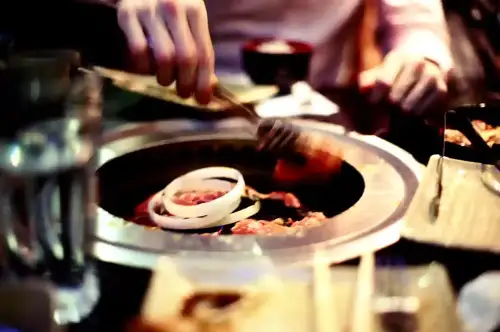Celiac.com 06/11/2025 - South Korea is known for its rich culinary traditions, high-tech conveniences, and incredible landscapes. But if you're living with celiac disease or gluten sensitivity, the thought of navigating Korea’s soy sauce-heavy dishes, wheat-based noodles, and hidden ingredients might feel overwhelming. The good news? With the right preparation, a gluten-free trip to Korea is absolutely doable—and delicious.
This guide will help you discover safe Korean foods, navigate grocery stores, dine out with confidence, and connect with useful apps and resources. Whether you're heading to Seoul, Busan, or exploring the countryside, you’ll be equipped for a worry-free journey.
Is Korea Gluten-Free Friendly?
Celiac.com Sponsor (A12):
While South Korea is not inherently gluten-free friendly due to the widespread use of soy sauce, wheat noodles, and barley in traditional cooking, awareness is slowly growing. Major cities like Seoul and Busan offer more international options, and a few gluten-free and allergy-aware establishments are beginning to appear. The key is planning ahead, learning basic Korean food vocabulary, and using tools to help communicate your dietary needs clearly.
Common Korean Ingredients That Contain Gluten
- Gan-jang (간장) – Regular soy sauce, made with wheat
- Myeon (면) – Noodles, often made from wheat (e.g., ramyeon, kalguksu)
- Twigim (튀김) – Fried foods coated in wheat flour batter
- Gochujang (고추장) – Fermented chili paste that may contain wheat or barley
- Barley (보리) – Frequently used in tea (boricha) or mixed rice (boribap)
Gluten-Free Korean Foods to Try
Despite the challenges, there are many naturally gluten-free Korean dishes. Look for these traditional items that are often safe (but always confirm ingredients):
- Samgyeopsal (삼겹살) – Grilled pork belly, cooked at the table and served with rice and lettuce wraps
- Bibimbap (비빔밥) – Mixed rice bowl with vegetables and egg (ask for no soy sauce or gochujang)
- Sundubu-jjigae (순두부찌개) – Spicy soft tofu stew (ensure soy sauce-free version)
- Baek-kimchi (백김치) – White kimchi without chili or seafood (less likely to contain wheat)
- Japchae (잡채) – Stir-fried glass noodles made from sweet potato starch (confirm no soy sauce)
How to Communicate Your Gluten-Free Needs in Korean
Use translation cards and apps to help you explain your dietary restrictions. Here's a helpful phrase in Korean:
Quote저는 글루텐에 알레르기가 있습니다. 밀, 보리, 간장, 고추장, 튀김 요리를 먹을 수 없습니다. 저를 위해 안전한 음식을 만들어 주실 수 있나요?
(I have a gluten allergy. I cannot eat wheat, barley, soy sauce, gochujang, or fried foods. Can you make safe food for me?)
Consider printing a gluten-free restaurant card in Korean.
Apps to Help You Stay Gluten-Free in Korea
- Google Translate – Use camera translation for menus and ingredient labels
- Find Me Gluten Free – Limited Korean listings but helpful for reviews in major cities
- HappyCow – Excellent for locating vegan/vegetarian places, some of which offer gluten-free options
- Shazam – Use for identifying unfamiliar foods or packaging when paired with image search
Gluten-Free Restaurants in Korea
Although not widespread, here are some restaurants and cafes offering gluten-free or allergy-aware options (be sure to confirm before dining):
- Sunny Bread (Seoul) – 100% gluten-free bakery offering breads, cakes, and cafe food
- Plant Cafe (Seoul) – Vegan-friendly with gluten-free options clearly marked
- Haap (Seoul) – Traditional Korean rice cakes (tteok) often made without wheat; check individual ingredients
- Root Honest Food (Busan) – Healthy eatery with customizable gluten-free bowls and salads
Grocery Shopping Gluten-Free in Korea
Major supermarkets often carry international brands with gluten-free labeling. Korean labeling laws may not explicitly mention gluten, so look for ingredients like wheat (밀), barley (보리), and soy sauce (간장), and using the Google Translate camera app will be very helpful then looking at ingredient labels.
Supermarkets and Convenience Stores
- Emart – Large supermarket chain with imported foods and organic sections
- Homeplus – Similar to Emart, sometimes stocks gluten-free pastas and snacks
- Olive Young – Health and beauty chain that carries imported gluten-free snacks and protein bars
- GS25 & CU – Convenience stores with limited options (look for rice snacks and plain yogurt)
Look for These Gluten-Free Korean Snacks:
- Yogurt or probiotic drinks (check sugar content and flavorings)
- Roasted seaweed (김 or gim)
- Plain rice crackers (쌀과자) – Some are gluten-free, but always verify ingredients
- Rice cakes (tteok) – Some types are gluten-free, but others contain soy sauce or flour
Staying in Korea with Celiac Disease
Hotels and Accommodations
When booking your stay, consider accommodations with kitchenettes so you can cook some meals yourself. Many Airbnb listings in Seoul or Jeju Island offer full kitchens. Major hotel chains like Marriott, InterContinental, and Lotte Hotel may accommodate dietary requests if notified in advance.
Transportation Tips
Public transport is clean, efficient, and widely accessible. Pack gluten-free snacks for longer train or bus journeys, especially if traveling to rural areas with fewer food options. Some stations in Seoul and Busan have Western-style convenience stores with gluten-free snack bars.
Final Thoughts
Traveling to Korea with celiac disease or a gluten sensitivity does take preparation—but the rewards are well worth it. From sizzling tabletop BBQ to peaceful Buddhist temples, Korea offers unforgettable experiences. With the right tools and awareness, you can enjoy it all without compromising your health.










Recommended Comments
There are no comments to display.
Create an account or sign in to comment
You need to be a member in order to leave a comment
Create an account
Sign up for a new account in our community. It's easy!
Register a new accountSign in
Already have an account? Sign in here.
Sign In Now